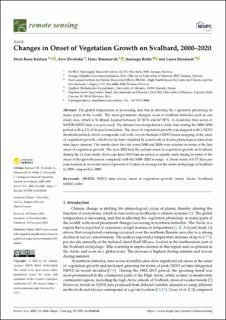| dc.contributor.author | Karlsen, Stein Rune | |
| dc.contributor.author | Elvebakk, Arve | |
| dc.contributor.author | Tømmervik, Hans | |
| dc.contributor.author | Belda, Santiago | |
| dc.contributor.author | Stendardi, Laura | |
| dc.date.accessioned | 2023-01-05T09:47:24Z | |
| dc.date.available | 2023-01-05T09:47:24Z | |
| dc.date.created | 2022-12-16T12:16:19Z | |
| dc.date.issued | 2022 | |
| dc.identifier.issn | 2072-4292 | |
| dc.identifier.uri | https://hdl.handle.net/11250/3041134 | |
| dc.description.abstract | The global temperature is increasing, and this is affecting the vegetation phenology in many parts of the world. The most prominent changes occur at northern latitudes such as our study area, which is Svalbard, located between 76300N and 80500N. A cloud-free time series of MODIS-NDVI data was processed. The dataset was interpolated to daily data during the 2000–2020 period with a 231.65 m pixel resolution. The onset of vegetation growth was mapped with a NDVI threshold method which corresponds well with a recent Sentinel-2 NDVI-based mapping of the onset of vegetation growth, which was in turn validated by a network of in-situ phenological data from time lapse cameras. The results show that the years 2000 and 2008 were extreme in terms of the late onset of vegetation growth. The year 2020 had the earliest onset of vegetation growth on Svalbard during the 21-year study. Each year since 2013 had an earlier or equally early timing in terms of the onset of the growth season compared with the 2000–2020 average. A linear trend of 0.57 days per year resulted in an earlier onset of growth of 12 days on average for the entire archipelago of Svalbard in 2020 compared to 2000. MODIS; NDVI; time series; onset of vegetation growth; trend; Arctic; Svalbard; spatial scales | en_US |
| dc.language.iso | eng | en_US |
| dc.rights | Navngivelse 4.0 Internasjonal | * |
| dc.rights.uri | http://creativecommons.org/licenses/by/4.0/deed.no | * |
| dc.title | Changes in Onset of Vegetation Growth on Svalbard, 2000–2020 | en_US |
| dc.title.alternative | Changes in Onset of Vegetation Growth on Svalbard, 2000–2020 | en_US |
| dc.type | Journal article | en_US |
| dc.type | Peer reviewed | en_US |
| dc.rights.holder | © 2022 by the authors | en_US |
| dc.description.version | publishedVersion | en_US |
| cristin.ispublished | true | |
| cristin.fulltext | original | |
| cristin.qualitycode | 1 | |
| dc.identifier.doi | 10.3390/rs14246346 | |
| dc.identifier.cristin | 2094315 | |
| dc.source.journal | Remote Sensing | en_US |
| dc.source.volume | 14 | en_US |
| dc.relation.project | Norges forskningsråd: 269927 | en_US |
| dc.subject.nsi | VDP::Zoologiske og botaniske fag: 480 | en_US |
| dc.subject.nsi | VDP::Zoology and botany: 480 | en_US |

